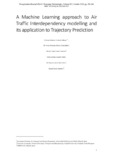JavaScript is disabled for your browser. Some features of this site may not work without it.
| dc.contributor.author | Verdonk Gallego, Christian Eduardo | |
| dc.contributor.author | Gómez Comendador, Victor Fernando | |
| dc.contributor.author | Carmona, Manuel Angel Amaro | |
| dc.contributor.author | Valdés, Rosa María Arnaldo | |
| dc.contributor.author | Nieto, Francisco Javier Sáez | |
| dc.contributor.author | Martínez, Miguel García | |
| dc.date.accessioned | 2019-08-28T09:49:20Z | |
| dc.date.available | 2019-08-28T09:49:20Z | |
| dc.date.issued | 2019-08-27 | |
| dc.identifier.citation | Verdonk Gallego CE, Gomez Comendador VF, Amaro Carmona MA, et al., (2019) A machine learning approach to air traffic interdependency modelling and its application to trajectory prediction. Transportation Research Part C: Emerging Technologies, Volume 107, October 2019, pp. 356-386. | en_UK |
| dc.identifier.issn | 0968-090X | |
| dc.identifier.uri | https://doi.org/10.1016/j.trc.2019.08.015 | |
| dc.identifier.uri | https://dspace.lib.cranfield.ac.uk/handle/1826/14478 | |
| dc.description.abstract | Air Traffic Management is evolving towards a Trajectory-Based Operations paradigm. Trajectory prediction will hold a key role supporting its deployment, but it is limited by a lack of understanding of air traffic associated uncertainties, specifically contextual factors. Trajectory predictors are usually based on modelling aircraft dynamics based on intrinsic aircraft features. These aircraft operate within a known air route structure and under given meteorological conditions. However, actual aircraft trajectories are modified by the air traffic control depending on potential conflicts with other traffics. This paper introduces surrounding air traffic as a feature for ground-based trajectory prediction. The introduction of air traffic as a contextual factor is addressed by identifying aircraft which are likely to lose the horizontal separation. For doing so, this paper develops a probabilistic horizontal interdependency measure between aircraft supported by machine learning algorithms, addressing time separations at crossing points. Then, vertical profiles of flight trajectories are characterised depending on this factor and other intrinsic features. The paper has focused on the descent phase of the trajectories, using datasets corresponding to an en-route Spanish airspace volume. The proposed interdependency measure demonstrates to identify in advance conflicting situations between pairs of aircraft for this use case. This is validated by identifying associated air traffic control actions upon them and their impact on the vertical profile of the trajectories. Finally, a trajectory predictor for the vertical profile of the trajectory is developed, considering the interdependency measure and other operational factors. The paper concludes that the air traffic can be included as a factor for the trajectory prediction, impacting on the location of the top of descent for the specific case which has been studied. | en_UK |
| dc.language.iso | en | en_UK |
| dc.publisher | Elsevier | en_UK |
| dc.rights | Attribution-NonCommercial-NoDerivatives 4.0 International | * |
| dc.rights.uri | http://creativecommons.org/licenses/by-nc-nd/4.0/ | * |
| dc.subject | Machine Learning | en_UK |
| dc.subject | Trajectory Prediction | en_UK |
| dc.subject | Air Traffic Management | en_UK |
| dc.subject | Vertical profile | en_UK |
| dc.subject | Air Traffic Control | en_UK |
| dc.subject | Artificial Neural Networks | en_UK |
| dc.subject | Flows | en_UK |
| dc.title | A machine learning approach to air traffic interdependency modelling and its application to trajectory prediction | en_UK |
| dc.type | Article | en_UK |
Files in this item
The following license files are associated with this item:
This item appears in the following Collection(s)
-
Staff publications (SATM) [4365]

